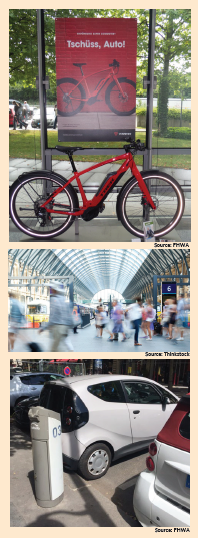U.S. Department of Transportation
Federal Highway Administration
1200 New Jersey Avenue, SE
Washington, DC 20590
202-366-4000
European countries such as France, Germany, and Belgium have made significant progress in fostering innovation and helping to establish and scale new transportation solutions. This progress is due to a number of factors in addition to those already highlighted in the previous chapter. These factors center on public sector and other leadership priorities, funding commitments, and public policy initiatives.

During the site visits, the study team was able to observe direct links between visionary leadership, reflected in forward thinking planning documents, and successful implementation of new ideas. The team also saw business leadership that strongly influenced acceptance of new ideas. In Munich, for example, it was the automakers that were leading the charge for new mobility solutions, offering carsharing, testing automated vehicles, and promoting electrification, all with strong government support.
On a local level, all three of the study cities provide examples of strong public sector leadership models for mobilizing interest in shared mobility. Notable examples include the Minister of Mobility and Public Works at the Brussels Capital Region, the City of Munich's Head of Strategy and Policy Division for the Road Transport Department in the Department of Public Order, and the former and current mayors of Paris, all of whom have mobilized interest in shared mobility through shepherding innovative policies and plans for their cities. While we have seen similar efforts by mayors in the United States, these European leaders are looking beyond their immediate jurisdictions and have made a compelling case for broadening transportation choice to bring about positive outcomes for entire regions.
These leaders have linked better transportation options very clearly with economic development and job access. They have also focused on "choice" and emphasized multimodal lifestyles as well as economic factors such as the high cost of auto ownership and the health and environmental benefits of transit, walking, and shared mobility. In addition, they are rallying support around common interests in meeting the needs of the elderly and others who cannot drive.
The EU has allocated some €26 billion ($28.1 billion in 2017 dollars) to transportation over the 2014-2020 period.53 It leverages these funds in a number of ways, including supporting research, deployment projects, planning and regional goal setting. The EU has established a wide range of initiatives, networks, and organizations to support efforts to advance new transportation solutions.
These include:
In August 2017, the EC announced it would launch a new and innovative way to finance transport infrastructure projects in Europe. It issued a call for proposals seeking to combine €1 billion ($1.1 billion in 2017 dollars) of grants from the Connecting Europe Facility – Transport program with financing from public financial institutions and the private sector to boost investment to fund innovative, sustainable transport infrastructure. The initiative also coincides with the Commission's Strategy for Low-Emission Mobility and supports other investments in sustainable transport.
While shared mobility is not the explicit objective of any of these initiatives, there seems to be a collective vision that it may be part of the solution. These organizations and initiatives can direct activities chiefly through setting goals and directives and otherwise fostering cooperation. While they can do little in the way of actual enforcement, they can encourage and cajole to bring about action.
The EU has also established a number of policies and agreements that have helped to spur innovation in shared mobility, including:
53 European Union, "EU transport policy," n.d., Available at: https://europa.eu/european-union/topics/transport_en. [ Return to note 53. ]
54 See more at: https://ec.europa.eu/commission/priorities/energy-union-and-climate_en. [ Return to note 54. ]
55 See more at: https://ec.europa.eu/commission/priorities/digital-single-market_en. [ Return to note 55. ]
56 See more at: https://ec.europa.eu/commission/priorities/jobs-growth-and-investment_en. [ Return to note 56. ]